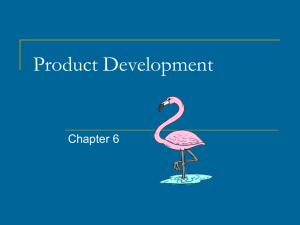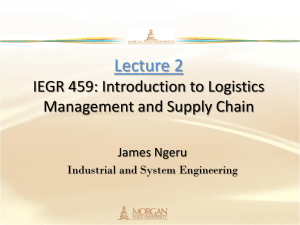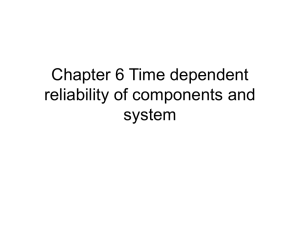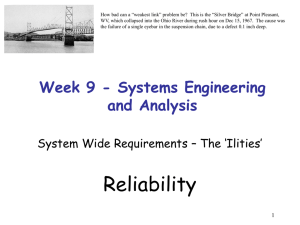Duane Model History and Development
advertisement
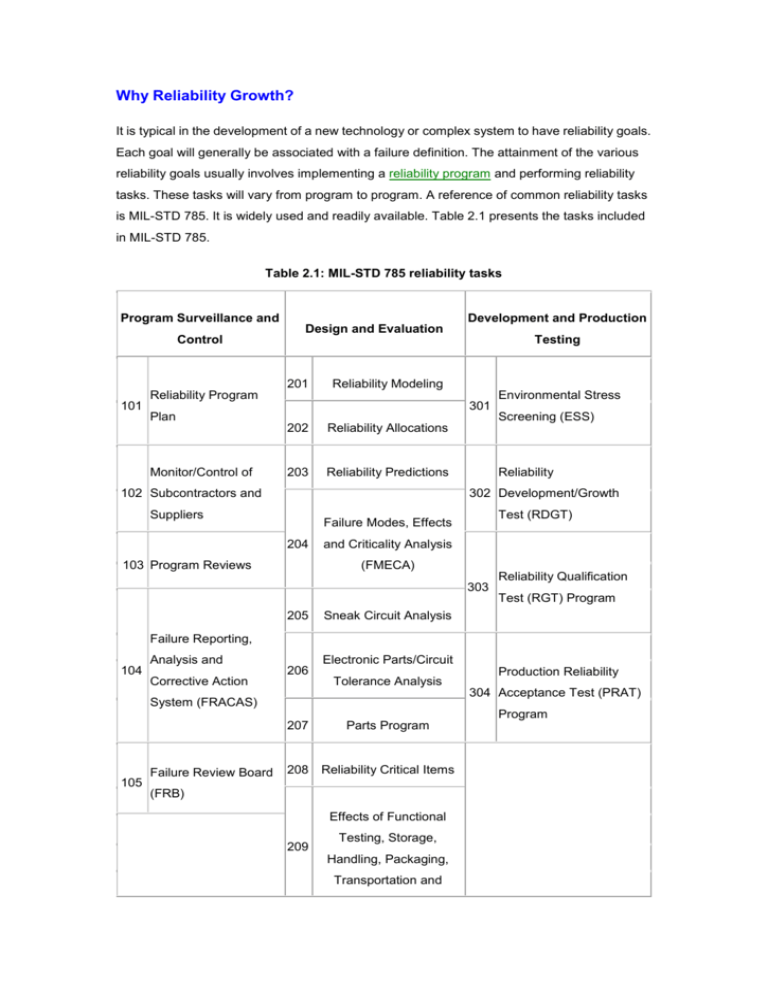
Why Reliability Growth? It is typical in the development of a new technology or complex system to have reliability goals. Each goal will generally be associated with a failure definition. The attainment of the various reliability goals usually involves implementing a reliability program and performing reliability tasks. These tasks will vary from program to program. A reference of common reliability tasks is MIL-STD 785. It is widely used and readily available. Table 2.1 presents the tasks included in MIL-STD 785. Table 2.1: MIL-STD 785 reliability tasks Program Surveillance and Control Design and Evaluation 201 101 Testing Reliability Modeling Reliability Program 301 Plan Monitor/Control of Development and Production 202 Reliability Allocations 203 Reliability Predictions 102 Subcontractors and Environmental Stress Screening (ESS) Reliability 302 Development/Growth Suppliers Test (RDGT) Failure Modes, Effects 204 103 Program Reviews and Criticality Analysis (FMECA) 303 205 Reliability Qualification Test (RGT) Program Sneak Circuit Analysis Failure Reporting, 104 Analysis and Corrective Action 206 Electronic Parts/Circuit Tolerance Analysis Production Reliability 304 Acceptance Test (PRAT) System (FRACAS) Program 207 105 Failure Review Board Parts Program 208 Reliability Critical Items (FRB) Effects of Functional 209 Testing, Storage, Handling, Packaging, Transportation and Maintenance The Program Surveillance and Control and Design and Evaluation tasks can be combined into a group called basic reliability tasks. These are basic tasks in the sense that many of these tasks are included in a comprehensive reliability program. Of the MIL-STD 785 300 series tasks, only the RDGT reliability growth testing task is specifically directed toward finding and correcting reliability deficiencies. For discussion purposes, consider the reliability metric mean time between failures (MTBF). This term is used for continuous systems, as well as one shot systems. For one shot systems this metric is the mean trial or shot between failures and is equal to . The MTBF of the prototypes immediately after the basic reliability tasks are completed is called the initial MTBF. This is a key basic reliability task output parameter. If the system is tested after the completion of the basic reliability tasks then the initial MTBF is the mean time between failures as demonstrated from actual data. The initial MTBF is the reliability achieved by the Basic Reliability Tasks and would be the system MTBF if the reliability program were stopped after the basic reliability tasks have been completed. The initial MTBF after the completion of the basic reliability tasks will generally be lower than the goal. If this is the case then a reliability growth program is appropriate. Formal reliability growth testing is usually conducted after the basic reliability tasks have been completed. For a system subjected to RDGT, the initial MTBF is the system reliability at the beginning of the test. The objective of the testing is to find problems, implement corrective actions and increase the initial reliability. During RDGT, failures are observed and an underlying failure mode is associated with each failure. A failure mode is defined by a problem and a cause. When a new failure mode is observed during testing, management makes a decision to either not correct or correct the failure mode in accordance with the management strategy. Failure modes that are not corrected are called A modes and failure modes that receive a corrective action are called B modes. If the corrective action is effective for a B mode, then the failure intensity for the failure mode will decrease. The effectiveness of the corrective actions is part of the overall management strategy. If the RDGT testing and corrective action process are conducted long enough the system MTBF will grow to a mature MTBF value in which further corrective actions are very infrequent. This mature MTBF value is called the growth potential. It is a direct function of the design and management strategy. The system growth potential MTBF is the MTBF that would be attained at the end of the basic reliability tasks if all the problem failure modes were uncovered in early design and corrected in accordance with the management strategy. In summary, the initial MTBF is the value actually achieved by the basic reliability tasks. The growth potential is the MTBF, with the current management strategy, that can be attained if the test is conducted long enough. See Figure 2.1. Figure 2.1: Growth potential and management strategy. Duane Model History and Development In 1962, J. T. Duane published a report in which he presented failure data of different systems during their development programs [8]. While analyzing the data, it was observed that the cumulative MTBF versus cumulative operating time followed a straight line when plotted on log-log paper (Figure 4.1). Figure 4.1: Cumulative MTBF vs. Cumulative Test Time postulated by Duane Based on that observation, Duane developed his model as follows. If failures by time , the observed mean (average) time between failures, is the number of at time is: (Note: The development or TAAF (Test-Analyze-And-Fix) time considered in reliability growth in terms of the MTBF, failure rate or reliability improvement for continuously operating units, is the unit hours accumulated by one or more units involved in the growth process. For one-shot items, the TAAF time considered in reliability growth is the accumulated number of missions, events, launches, or discrete periods of operation, e.g. month of TAAF or cycles of operations to a failure.) The equation of the line can be expressed as: Setting: yields: Then equating to its expected value, and assuming an exact linear relationship, gives: or: (1) And, if you assume a constant failure intensity, then the cumulative failure intensity, or: (2) Also, the expected number of failures up to time is: , is: (3) where: The corresponding , or , is equal to: (4) where cumulative MTBF at which the first or at the beginning of the test, or the earliest time at can be determined, or the development process ( ). The cumulative MTBF, , and predicted at the start of the design and tell whether is increasing or is decreasing with time, utilizing all data up to that time. You may want to know, however, the instantaneous or to see what you are doing at a specific instant or after a specific test and development time. The instantaneous failure intensity, , is: (5) Similarly, using Eqn. 3, this procedure yields: (6) where implies infinite MTBF growth. It can be seen from Eqn. 5 that the instantaneous failure intensity improvement line is obtained by shifting the cumulative failure intensity line down, parallel to itself, by a distance of . Similarly, it can be seen from Eqn. 6 that the current or instantaneous MTBF growth line is obtained by shifting the cumulative MTBF line up, parallel to itself, by a distance of illustrated in Figure 4.1. , as Parameter Estimation for the Duane Model The Duane model is a two parameter model. Therefore, to use this model as a basis for predicting the reliability growth that could be expected in an equipment development program, procedures must be defined for estimating these parameters as a function of equipment characteristics. Note that, while these parameters can be estimated for a given data set using curve-fitting methods, there exists no underlying theory for the Duane model that could provide a basis for a priori estimation. Graphical Method Eqn. 2 may be linearized by taking the natural log of both sides. (7) Consequently, plotting versus on log-log paper will result in a straight line with a negative slope, such that: Similarly, Eqn. 4 can also be linearized by taking the natural log of both sides: (8) Plotting versus on log-log paper will result in a straight line with a positive slope such that: Two ways of determining these curves are as follows: 1. Predict the and of the system from its reliability block diagram and available component failure intensities. Plot this value on log-log plotting paper at From past experience and from past data for similar equipment, find values of Modify this , the slope of the improvement lines for or . as necessary. If a better design effort is expected and a more intensive research, test and development or a TAAF program is to be implemented, then a improvement in the growth rate may be attainable. Consequently, the available value for , , should be adjusted by this amount. The value to be used will then be through point that and is negative for the A line is then drawn with the just determined slope , keeping in mind curve. This line should be extended to the design, development and test time scheduled to be expended to achieve the failure intensity goal to see if this goal will indeed be achieved on schedule. It is also possible to find the design, development and test time to achieve the goal that may be earlier than the delivery date or later. If earlier, then either the reliability program effort can be judiciously and appropriately trimmed; or if it is an incentive contract, full advantage is taken of the fact that the failure intensity goal can be exceeded with the associated increased profits to the company. A similar approach may be used for the MTBF growth model, where plotted at slope , and a line is drawn through the point to obtain the MTBF growth line. If Table 4.1, which gives actual and is with values are not available, consult values for various types of equipment. These have been obtained from the literature or by MTBF growth tests. It may be seen from Table 4.1 that values range between 0.24 and 0.65. The lower values reflect slow early growth and the higher values reflect fast early growth. 2. During the design, development and test phase and at specific milestones, the These values of is calculated from generated total failures and or are plotted above the corresponding values. values on log-log paper. A straight line is drawn favoring these points to minimize the distance between these points and the line, thus establishing the improvement or growth model and its parameters, graphically. If needed, linear regression analysis techniques can be used to determine these parameters. Table 4.1 - Sample values for the slope ( for various equipment Slope Equipment ( Computer system ) Actual 0.24 Easy to find failures were eliminated 0.26 All known failure causes were eliminated 0.36 Mainframe computer Aerospace electronics 0.50 All malfunctions 0.57 Relevant failures only 0.65 Attack radar 0.60 Rocket engine 0.46 Afterburning turbojet 0.35 Complex hydromechanical system 0.60 Aircraft generator 0.38 Modern dry turbojet 0.48 Duane Example 1 A complex system's reliability growth is being monitored and the data set is given in Table 4.2. Do the following: 1. Plot the cumulative MTBF growth curve. 2. Write the equation of this growth curve. 3. Write the equation of the instantaneous MTBF growth model. 4. Plot the instantaneous MTBF growth curve. Table 4.2 - Cumulative test hours and the corresponding observed failures for the complex system of Example 1 Point Cumulative Test Cumulative Cumulative Instantaneous Number Time (hr) Failures MTBF (hr) MTBF (hr) 1 200 2 100.0 100 2 400 3 133.0 200 3 600 4 150.0 200 4 3,000 11 273.0 342.8 Solution to Duane Example 1 1. Given the data in the second and third columns of Table 4.2, the cumulative MTBF, , values are calculated in the fourth column. The information in the second and fourth columns is then plotted. Figure 4.2 shows the cumulative MTBF while Figure 4.3 shows the instantaneous MTBF. It can be seen that a straight line represents the MTBF growth very well on log-log scales. Figure 4.2: Cumulative MTBF plot for Example 1 Figure 4.3: Instantaneous MTBF plot for Example 1 By changing the x-axis scaling, you are able to extend the line to value of . You can get the from the graph by positioning the cursor at the point where the line meets the y-axis. Then read the value of the y-coordinate position at the bottom left corner. In this case, approximately hr. Figure 4.4 illustrates this. is Figure 4.4: Cumulative MTBF plot for 14 hr at Figure 4.5: Cumulative and Instantaneous MTBF vs. Time plot Another way of determining is to calculate and substituting the corresponding and by using two points on the fitted straight line values into: (9) Then substitute this The slope of the line, and choose a set of values for and , may also be found from Eqn. 8 or from: into Eqn. 4 and solve for . (10) Using the plot in Figure 4.2, at hr; and hr and hr, hr when hr, and at hr, from Figure 4.4. Substituting the first set of values, , into Eqn. 9 yields: Substituting the second set of values, Averaging these two 2. hr and into Eqn. 9 yields: values yields a better estimate of . Now the equation for the cumulative MTBF growth curve is: (11) 3. The equation for the instantaneous MTBF growth curve using Eqn. 6 is: (12) Eqn. 12 is plotted in Figures 4.3 and 4.5. In Figure 4.5, you can see that a parallel shift upward of the cumulative MTBF, , line. , line by a distance of gives the instantaneous MTBF, or the
